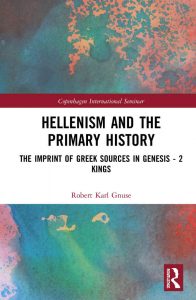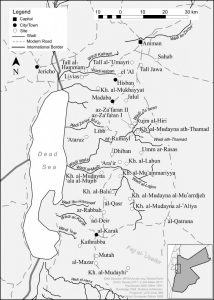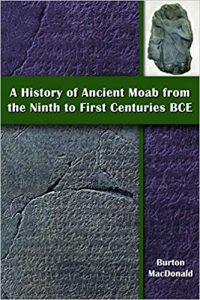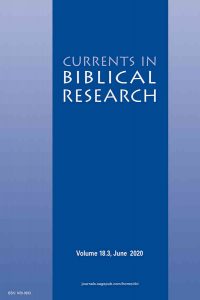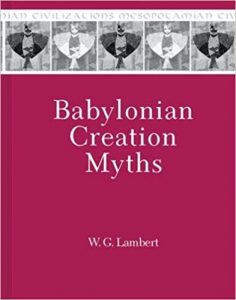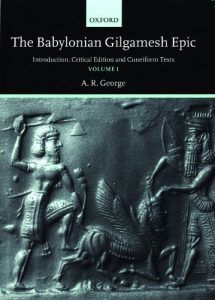Estou estudando nestes dias, com os alunos do Segundo Ano de Teologia do CEARP – desde meados de março através de videoconferência por causa da pandemia do coronavírus -, em Literatura Profética I, o texto do livro de Oseias. Além do capítulo sobre Oseias de meu livro A Voz Necessária: encontro com os profetas do século VIII a.C. – download aqui – vimos um texto sobre a Teoria da metáfora conceptual e estamos olhando o artigo Notas sobre a pesquisa do livro de Oseias no século XX, que recomendo como aprofundamento do que vem a seguir.
E o que vem a seguir é a apresentação de um artigo que li hoje:
HUBLER, C. ‘No longer will you call me ‘my Ba’al’’: Hosea’s polemic and the semantics of ‘Ba’al’ in 8th century B.C.E. Israel. Journal for the Study of the Old Testament 2020, Vol. 44(4), p. 610–623.
Caitlin Hubler – Emory University, GA, USA – diz nas páginas 610-612:
Em resposta à flagrante idolatria de Israel, o profeta Oseias faz uma série de pesadas acusações contra seus maiores líderes religiosos, equiparando-os a esposas adúlteras. Oseias 2 apresenta um esmagador julgamento de Iahweh (o esposo) contra Israel (a esposa infiel), com o objetivo de despertar Israel e conduzi-lo de volta às suas origens. Aparentemente, Israel está chamando Iahweh pelo nome errado, chamando-o de Baal.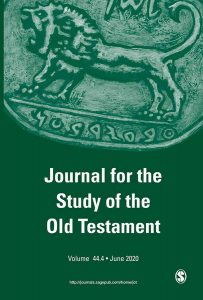
Diz Os 2,18-19, na tradução da Bíblia de Jerusalém, Paulus, 2002:
Acontecerá naquele dia,
– oráculo de Iahweh-
que me chamarás “Meu marido”,
e não mais me chamarás “Meu Baal”.
Afastarei de seus lábios os nomes dos baais,
para que não sejam mais lembrados por seus nomes.
Ao estudar Oseias, estudiosos da Bíblia tentam reconstruir a situação do Israel Norte do século VIII a.C. que teria motivado uma crítica profética tão veemente. A resposta oferecida até agora tem sido bastante direta: o culto a Baal, uma divindade conhecida no Antigo Oriente Médio, intimamente ligada à fertilidade, à agricultura e à criação de gado. Sugerem muitos estudiosos que os israelitas do norte capitularam às pressões da cultura cananeia circundante e, em vez de Iahweh, seguiram Baal. Variações dessa proposta foram feitas de acordo com a compreensão do estudioso da fluidez divina no Antigo Oriente Médio e sua aplicação a Baal. Indica a depreciação de Baal uma polêmica genérica contra todas as formas de adoração de ídolos? Existe uma divindade chamada ‘Baal’ com manifestações específicas em cada localidade? Seja qual for a formulação, o consenso geral é de que Oseias ficou indignado com o fato de uma grande parcela da população israelita ter deixado de seguir Iahweh e, em vez disso, passar a seguir Baal. Frequentemente essa interpretação rotula Oseias como um profeta que teme todo tipo de influência dos povos estrangeiros, sejam influências culturais ou religiosas. Este Oseias é quase xenófobo: seu maior desejo é manter a pureza ideológica da nação israelita.
Tal entendimento busca sustentação no livro de Oseias. De fato, Oseias deixa bem claro que ele está indignado pelo fato de os israelitas terem, em certo sentido, negligenciado seguir Iahweh corretamente. No entanto, há um questionamento sobre a natureza exata dessa situação. Podem existir muitas outras razões para Oseias duvidar do compromisso de Israel com Iahweh. Os oráculos de Oseias preservam apenas um lado de uma conversa multifacetada no século VIII a.C. sobre teologia e a identidade israelitas. Informações de outras fontes podem ser úteis em nossa tentativa de reconstruir uma imagem precisa das crenças israelitas desta época. Mais especificamente, evidências epigráficas e onomásticas nos ajudam a descobrir possibilidades alternativas para interpretar a situação de Israel no século VIII a.C. Ao longo deste artigo, com o apoio de tais evidências, sustentarei que a polêmica de Oseias contra Baal mira israelitas que sinceramente acreditavam estar seguindo fielmente a Iahweh. Na mente deles, não havia nada de errado em se referir a Iahweh como Baal.
O conflito que aparece em Oseias, portanto, é primariamente interno. Um debate sobre a integridade do próprio javismo. Tão aquecido quanto os debates inter-religiosos podem ser, controvérsias intrarreligiosas podem ser muito mais ferozes. No desacordo inter-religioso, os limites entre uma religião e outra são bastante nítidos. A dinâmica do poder se torna mais complexa quando o debate é interno por natureza. Quando a pergunta não é ‘Como defenderemos a causa dos israelitas contra a do grupo X?’, mas sim ‘O que significa ser um israelita?’, muitas perguntas podem ser feitas:
Qual é a natureza da aliança javista?
Quais são os estatutos e as normas que devemos seguir em nossa sociedade?
Quem tem o poder – político, religioso ou outro – de decidir como seguir Iahweh corretamente?
O estudo das respostas de Oseias a essas perguntas pode nos levar a uma maior compreensão da situação interna da religião israelita no século VIII a.C.
Caitlin Hubler defende que Baal em Oseias não é uma referência à divindade que leva esse nome, mas deve ser entendido como um título que se usa com diferentes divindades, portanto, também com Iahweh. Baal significa “senhor” ou “mestre”.
Ela diz na página 615:
Spencer L. Allen (The Splintered Divine: A Study of Istar, Baal, and Yahweh Divine Names and Divine Multiplicity in the Ancient Near East. Berlin: De Gruyter, 2015, p. 94) argumenta que vários nomes de divindades em acádico e nas línguas semíticas do noroeste [o hebraico é uma língua semítica do noroeste] são melhor interpretados não como nomes próprios, mas como títulos que mascaram os nomes reais das divindades. Ele lista Baal (‘mestre’ ou ‘senhor’) e Ishtar (‘deusa’) como exemplos: “Como Baal pode ser interpretado como um substantivo comum que serve como título e não como nome próprio, muitos estudiosos aceitam que havia divindades independentes e distintas de Baal que não deveriam ser identificadas nem com o deus da tempestade da Mesopotâmia, Adad [Baal-Adad], e nem com o deus da tempestade Hadad [Baal-Hadad], cultuado no Levante”. Se Allen estiver correto, e Baal fosse entendido como um título em vez de um nome próprio no Israel do século VIII a.C., então certamente os israelitas não teriam visto nenhuma contradição em chamar Iahweh de ‘meu Baal’. Longe de ser uma atitude idolátrica, isso pode ter sido visto como um elogio a Iahweh como o senhor todo-poderoso. Muitas evidências de fontes bíblicas e extrabíblicas sugerem que Baal nem sempre se referia ao culto de ídolos ao longo da história de Israel. O termo geralmente significa simplesmente “senhor” ou “mestre”.
J. Andrew Dearman (Interpreting the Religious Polemics against Baal and the Baalim in the Book of Hosea. Old Testament Essays 14/1, 2001, p. 9-25) sugere que inscrições extrabíblicas da Idade do Ferro, particularmente textos fenícios e púnicos, devam ter prioridade metodológica ao avaliar a semântica de Baal em Oseias. Ele mostra que “essas inscrições demonstram uma pluralidade de divindades, masculinas e femininas, que são chamadas com o apelativo Baal”.
E assim prossegue Caitlin Hubler citando fontes arqueológicas e literárias, bíblicas e extrabíblicas, e os autores que as interpretam.
Para concluir na página 621:
O que Oseias condenou não foi o culto idolátrico de Baal, mas a vivência incorreta do javismo. Ele não colocou frente a frente baalismo e javismo como duas religiões diferentes que disputavam os corações e as mentes dos israelitas, mas chamou Israel de volta a uma prática coerente da aliança. Viver de tal maneira que prejudicasse o significado da aliança era, para Oseias, perder completamente a identidade israelita. Era agir como uma esposa adúltera.
O que vemos no livro de Oseias é um profeta que pede desesperadamente que Israel viva com coerência sua identidade de povo escolhido de Iahweh.
Termino com Os 6,6:
Porque é solidariedade (hesedh) que eu quero e não sacrifício,
conhecimento de Deus [= prática do javismo] mais do que holocaustos.
In response to Israel’s flagrant idolatry, the prophet Hosea makes a series of shocking accusations against her greatest religious leaders, equating them to adulterous wives. In one oracle, Hosea delivers a crushing judgment from the mouth of YHWH designed to wake Israel up and call her back to her true roots. Apparently, she has been calling YHWH by the wrong name:
On that day, says the L ord , you will call me, ‘My husband’, and no longer will you call me, ‘My Ba’al’. For I will remove the names of the Ba’als from her mouth, and they shall be mentioned by name no more.
In studying Hosea, biblical scholars have attempted to reconstruct the situation in 8th-century Israel that would have precipitated such vehement prophetic critique. The answer offered thus far has been rather straightforward: worship of Ba’al-Hadad, a well-known deity in the ancient Near East, closely connected with fertility, field, and cattle. As the argument goes, the Israelites in the North had capitulated to the pressures of the surrounding Canaanite culture, and rather than holding to the uniqueness of their one God, YHWH, they worshipped Ba’al instead. Varieties of this response have been offered according to the particular scholar’s understanding of divine fluidity in the Ancient Near East and its application to Ba’al. Does denigration of Ba’al indicate a generic polemic against all forms of idol-worship? Is there one deity named ‘Ba’al’ with many location-specific manifestations? Whatever the formulation, the general consensus is that Hosea was incensed that large swaths of Israelites had ceased worshipping YHWH and had started to worship Ba’al instead. Often, this interpretation casts Hosea as a prophet who fears every sort of influence from foreign peoples: cultural and religious alike. This Hosea is nearly xenophobic: his greatest desire is to maintain the ideological purity of the nation of Israel.
Such an understanding is not without warrant from the text. Indeed, Hosea makes it abundantly clear that he is enraged by the fact that the Israelites have, in some sense, neglected to worship YHWH rightly. Questions remain, however, as to the exact nature of this failure. There could be many reasons for Hosea to doubt Israel’s commitment to YHWH. Hosea’s words preserve one side of a multifaceted conversation in the 8th century regarding Israelite theology and identity. Insights from elsewhere may be useful in our attempt to reconstruct an accurate picture of Israelite worship in this time period. Specifically, epigraphic and onomastic evidence assist us in discovering alternative possibilities for interpreting the situation of 8th-century Israel. Throughout this article, with the support of such evidence, I will maintain that Hosea’s polemics against Ba’al target Israelites who sincerely believed themselves to be faithfully worshipping YHWH. In their minds, there was nothing adulterous about referring to YHWH as Ba’al.
The conflict reflected in Hosea, therefore, is primarily an internal one: a debate about the integrity of YHWHism itself. As heated as interreligious debates can get, intra-religious debates can be far more contentious. In interreligious disagreement, boundaries between one religion and another are drawn fairly rigidly. Power dynamics become more complex when the debate is internal in nature. When the question is not ‘How will we advance the cause of the Israelites against that of group X?’ but is instead ‘What does it mean to be an Israelite?’ all sorts of questions are necessarily on the line: What is the nature of YHWH’s covenant? How will we insist on conformity to societal standards? Who has the power (political, religious, or otherwise) to decide how to worship YHWH rightly? Studying Hosea’s answers to these questions can bring us to a greater understanding of the internal coherence of Israelite religion in the 8th century BCE.
Spencer L. Allen argues that various Akkadian and Northwest Semitic deities’ first names are best interpreted not as proper names, but as categorical labels that mask the deities’ real first names. He lists Ba’al (‘master’ or ‘lord’) and Ishtar (‘goddess’) as examples: ‘Because Ba’al can be interpreted as a common noun that serves as a title rather than a name, many scholars accept that there were independent and distinct Ba’al deities who should not be identified with either the Mesopotamian storm-god Adad or the Levantine storm-god Hadad’. If Allen is correct, and ‘ba’al’ was understood as a categorical label rather than a personal name in 8th-century Israel, then surely the Israelites would have seen no contradiction in calling YHWH ‘my Ba’al’. Far from idolatry, this could have been seen as praise of the uniquely all-powerful YHWH. Plentiful evidence from both biblical and extra-biblical sources suggests that ‘ba’al’ did not always refer to idol worship throughout the history of Israel. The term often simply means ‘lord’ or ‘master’. J. Andrew Dearman suggests that extra-biblical Iron Age inscriptions, particularly Phonecian and Punic texts, should be given methodological priority when assessing the semantics of ‘ba’al’ in Hosea. He finds that ‘These inscriptions demonstrate a plurality of deities, both male and female, who are addressed with the appellative Baal’ (p. 615).
What Hosea condemned was not idolatrous worship of Ba’al Hadad of Ugarit, but incorrect worship of YHWH. He did not pit Baalism against YHWHism as two different religions vying for Israelite loyalty, but called Israel back to a greater appreciation for the covenantal aspect of her own religion. He was no mere social agitator, but a prophet. To worship in such a way that maligned the significance of the covenant for Israelite religion was, for Hosea, to forfeit Israelite identity altogether. It was no better than acting as an adulterous wife. What we see in Hosea 2.16-17 is a prophet desperately pleading for his people to live and worship in congruency with their professed identity as the chosen and covenanted people of God (p. 621).

